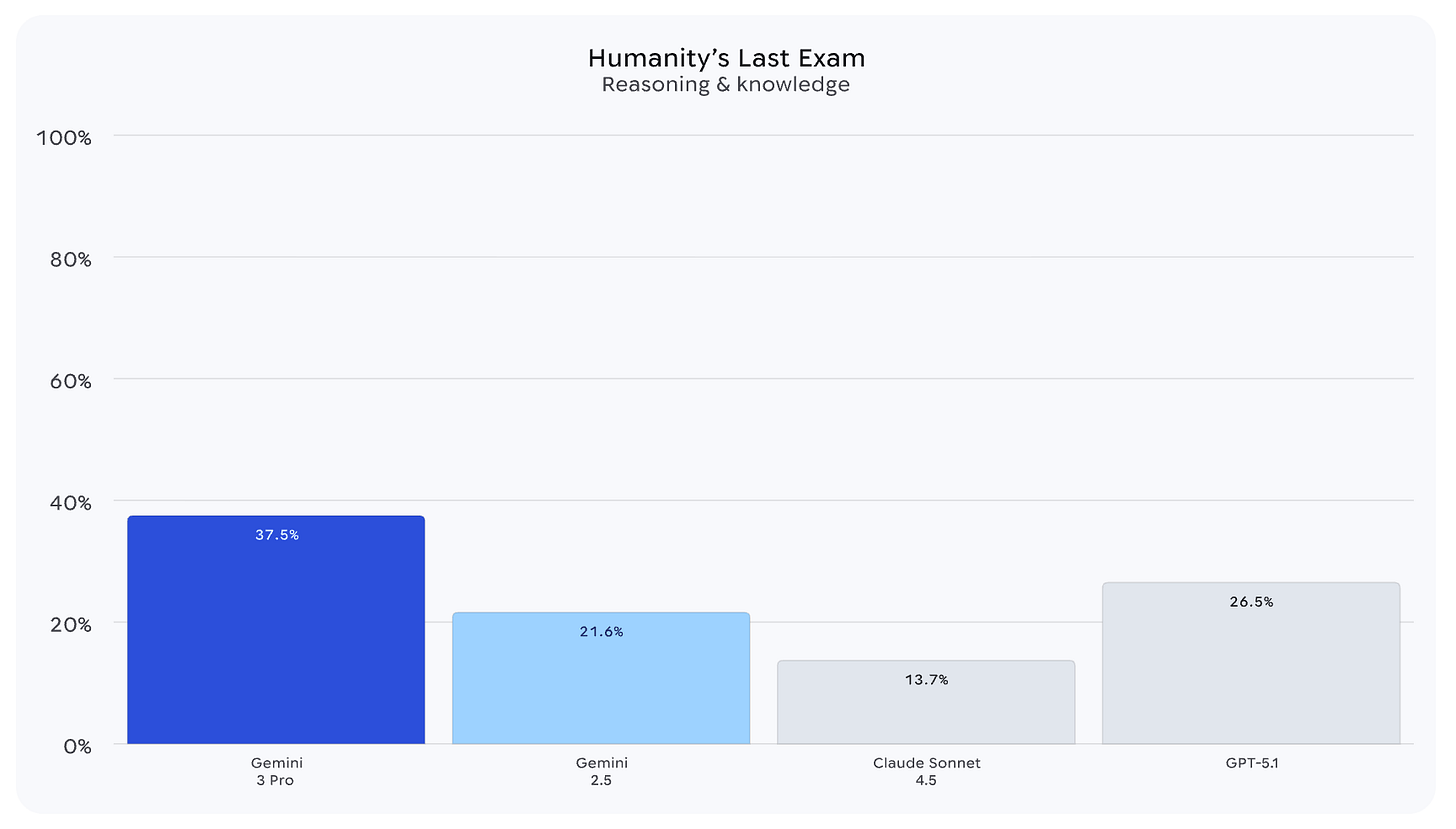3 teams getting real AI results right now
Forget the hype. Focus on Service, Marketing, and Operations. Here is the data.
Hi there,
Nine months ago, in February, I left my banking project management job to see what AI could actually do for real businesses.
Not in slide decks. Not in conference demos. In real firms where things break, customers complain, and processes are messy.
Since then, I’ve tested dozens of AI tools, built workflows and tools with agentic coding models, and developed a human-focused AI consulting offer while experimenting with different models and approaches. I watched the technology move from “interesting experiment” to “quietly useful tool embedded in daily work.”
What I’ve seen so far: businesses using AI are generally doing better than those that are not. The 2025 data points in the same direction. Is that permanent? We do not know yet. But the pattern is getting too consistent to ignore.
The technology keeps getting better, but differently now
In November 2025, four major AI models launched within two weeks: ChatGPT 5.1, Grok 4.1, Gemini 3 Pro, and Kimi K2 Thinking.
They keep improving. But the shape of improvement has changed.
When each new model was 50–100% better than the last, waiting for “the next big one” made sense. Gains were so large that being late still worked. When improvements are typically 5–15%, the balance shifts. Learning to use today’s tools may matter more than waiting for the next release. Whether that is true for you depends entirely on your business model and margins.
Growing businesses use AI more
Adoption is no longer a fringe phenomenon. In 2024, 39% of small businesses used AI. In 2025, that number is 55%. That’s a 41% relative increase in a single year.
The gap between growing and declining businesses is more striking:
Among growing businesses, 83% use AI.
Among declining businesses, 55% do.
Across multiple surveys, a consistent pattern shows up:
Businesses using AI are reported to grow 2.5× faster (McKinsey).
91% of small businesses using AI report more revenue (Salesforce).
They report getting back 3.7× what they spent.
Most of this is self-reported survey data. It is noisy. It does not prove that AI directly causes growth. Growing businesses may simply try more new things, or better management might drive both. The data cannot cleanly separate these. But across independent studies, the direction is consistent: AI-using businesses say they are pulling ahead.
Three areas where AI is delivering results
High-performing businesses tend to concentrate AI efforts in three areas rather than “doing AI everywhere.”
1. Customer Service (Most Common) 57% of businesses using AI apply it in customer service. Of these, 95% say response quality improved, and 92% say responses got faster. In some cases, AI chatbots handle up to 80% of routine questions before escalating to humans. Note: Results vary widely. Well-designed systems reduce response times. Poorly set up bots frustrate customers. The tools matter less than the implementation.
2. Marketing (High Priority) 77% of AI-using businesses say marketing is a priority. Typical uses: email content, campaign improvements, lead scoring, and creative testing. Example: Jordan Craig, an apparel business, reported a 54% increase in email revenue year-over-year after reworking its email program with AI tools. Marketing is where many businesses are comfortable experimenting first because the risks are lower and results are easy to measure.
3. Operations (Efficiency and Decision-Making) 62% use AI for data analysis, 55% for content creation, and 47% for general productivity. Surveys suggest businesses save, on average, around 20 hours per month per employee involved. Example: ZUS Coffee reported 107% more ecommerce revenue year-over-year, attributing 47% of that to AI-influenced channels. Behind numbers like this are usually dozens of small operational changes, not one “magic” tool.
Why many businesses still wait
Even with these reported gains, 45% of small businesses have not tried AI at all. Their concerns are not irrational.
Cost (55% concerned): AI pilots typically cost between $2,680 and $13,400 for three to six months. That is not the six-figure number many people assume, but it is also not trivial. A lot of that cost tends to come from integration and change work, not just software licences.
Skills gap (62% concerned): Many leaders know they do not have AI skills in-house. But there is a mismatch: only 33% of businesses using AI trained their staff, while 94% of workers say they want to learn. The skills gap is, to a large extent, self-inflicted.
Privacy and data risk (52% concerned): This is especially acute for firms handling sensitive customer data. Blindly pasting proprietary data into consumer tools is a genuine risk.
There is also a perception gap. 80% of AI users think the technology is now common. Only 33% of non-users think so. If you assume “none of my competitors are doing this yet,” you might simply be wrong.
Most AI pilots fail — usually for avoidable reasons
KPMG research shows 70–90% of AI pilots never make it into real, sustained use. This failure rate feeds the old playbook: “Wait until this matures.”
But when you look at why projects fail, the reasons are mostly organisational, not technical:
Starting with “What can we do with AI?” instead of a specific business problem.
No clear success metric or target.
Poor or fragmented data.
No training or support for staff.
No plan for who owns the system if the pilot works.
Businesses that treat AI as “buying some software” tend to struggle. Businesses that treat it as “changing how work gets done” report better results.
Why starting early might now be the safer move

The old technology playbook said: let others experiment. Wait until things are settled. For AI, the data increasingly suggests the opposite: waiting may be the riskier option.
AI models are getting better every few months - the sooner to start to build the “learning muscle” from what works and doesn’t work in your business, the better you’ll be at adapting in the AI era.
McKinsey’s research shows that between 2020 and 2023, companies that adopted digital technologies and AI early pulled 60% further ahead in financial performance than those that delayed.
A key dynamic here: AI systems get better with use. The more you use them, the more organisation-specific data you gather. Those improvements are hard for late adopters to copy quickly. As Harvard Business School professors Bharat Anand and Andy Wu put it: “Leaders cannot afford to take a ‘wait and see’ approach to adopting generative AI.”
Five patterns that seem to work
Based on current research and my own work, successful AI efforts tend to share a few patterns.
1. Start with business problems, not technology. Do not start with “What can we do with AI?” Start with: Where does work routinely break down? Where do people complain? The question is: “Where could automation create real business value?”
2. Pick one focused test. Do one thing. An internal chatbot for HR questions. Automated summaries of key documents. Define success before you start. Write it down: “If we can cut response time by 30% without lowering satisfaction, we’ll roll this out.”
3. Train people before buying tools. Resist the urge to buy tools first and “figure it out later.” The pattern in successful companies is clear: they invest in basic literacy across teams before deployment.
4. Test small and learn fast. Most pilots that work show meaningful signs of improvement within 4–12 weeks. If you are three months into a pilot with no visible benefit, the use case may not be suitable, or the design is too complex.
5. Plan for real use from day one. Even a small pilot needs to answer: Who owns this if it works? How will data be handled? If no one is clearly accountable for the system beyond the experiment, you do not have a pilot. You have a press release project.
What limits these conclusions
I am not neutral in this story. My work is currently focused on AI for business. That creates both financial and intellectual incentives to see the technology positively.
The research has limits too. Most studies show correlation, not causation. When we see that AI-using businesses grow faster, it might mean AI is a driver, or it might mean better-run businesses adopt AI earlier.
What seems real, even through that noise, are the patterns: More small and medium businesses are adopting AI. Many report concrete benefits. Some are using it to build advantages over direct competitors. We do not yet know how durable those advantages will be. But we can see they exist.
What to think about if you run a small or medium business
If you run a small or medium business and have not tried AI yet, the data suggests there is value in at least one focused, disciplined experiment.
That does not mean overhauling everything. It means choosing one painful problem, running one tightly scoped pilot, training the people involved, and measuring results honestly.
The evidence so far points the same way: businesses that learn to use AI are, on average, creating an advantage over those that wait. We do not know how long that window stays open. We do know that “wait until it all settles down” now carries its own risk.
If the technology is not your real problem
In many organisations, the hardest part is not the tools. It is the people, habits, incentives, and fears.
If you are trying to move forward and finding that the “people part” is harder than the technology, I can help. I offer focused AI Change Leadership sessions designed to:
Identify exactly where your organisation is getting stuck.
Connect AI efforts to real business problems and metrics.
Design practical, low-drama pilots that your team can actually run.
Build the basic skills and guardrails needed for responsible use.
If you are serious about unblocking your transformation and want to move faster, let’s talk - book in a call now.
How do you think AI is evolving for small and medium sized business owners? Leave a comment below or reply to this email - I’d love to hear from you.
Regards,
Brennan



Marketing and operations are a surprise entrant for me. Customer service isn't a surprise as much. Personally, I have used AI workflows in marketing, but wasn't aware that it has already become a domain getting real productivity benefits at large (to be honest, I have gone a long way back and forth this year on how far AI helps). Thanks for sharing this data, Brennan. Oh and those patterns. They really seem to offer a practical way to get started!